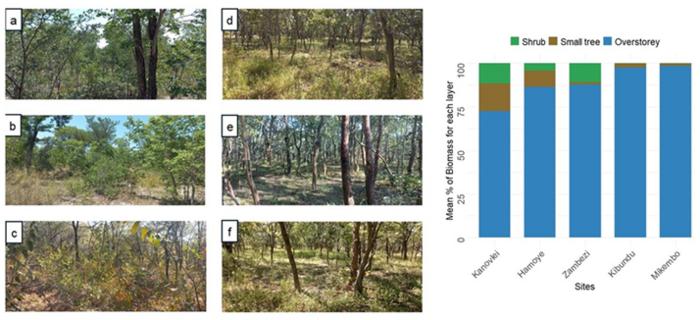
Amidst the enigmatic landscapes of eastern and southern Africa lies the Miombo ecoregion, a treasure trove of biodiversity characterized by its diverse assemblage of flora. Traditionally, scientific inquiries within this rich ecological domain have predominantly scrutinized the grandiose large trees that define the forest canopy. However, an emerging narrative is challenging the conventional framework of understanding these ecosystems by spotlighting the often-overlooked understorey layer. The understorey, encompassing small trees and shrubs that flourish beneath the towering canopies, is emerging as an equally significant player in the climate change dialogue, particularly in terms of carbon storage and ecosystem health.
Recent research conducted by a team of international scientists reveals that the understorey is not merely a mundane backdrop but a vibrant component of the forest ecosystem that contributes substantially to woody biomass and biodiversity. Lead author Hermane Diesse, a doctoral candidate at the Namibia University of Science and Technology, elucidates that in drought-prone regions, such as Namibia, small trees and shrubs may account for nearly one-third of the total woody biomass. This pivotal finding underscores a critical oversight in current biomass assessments, which often disregard these smaller yet essential flora, thereby underestimating the ecological value of the Miombo woodlands.
The team focused on the nuanced interplay between the understorey vegetation and forest structure across varying climatic conditions. Their comprehensive analysis emphasizes how species diversity within the understorey shifts in response to the biomass density of the overstorey trees. Notably, as the overstorey biomass increases, the species richness of shrubs diminishes, revealing a fascinating dynamic whereby the presence of large trees can dictate the ecological narrative of the understorey.
Conversely, the research also illuminates that an increase in the biomass of larger trees does not inherently diminish the number of understorey tree species. Instead, dense overstorey canopies often serve as a conducive environment for the proliferation of young trees in the understorey, promoting a delicate balance within the ecosystem. This correlation indicates the intricate relationships that govern forest dynamics and challenges the simplistic views often held about these ecosystems.
Publishing their findings in the esteemed Forest Ecosystem Journal, the researchers initiated a broader discussion about carbon assessment protocols that predominantly focus on large trees while neglecting smaller woody plants. The traditional methodologies employed in carbon assessments have largely been modeled on findings from well-watered Miombo systems. This reliance poses significant gaps in understanding the comprehensive carbon stock estimates, particularly in arid and semi-arid ecosystems where the contribution of small trees and shrubs might be particularly significant.
One key revelation from this study centers around the notion that understorey biomass is resilient, remaining relatively unchanged even as one moves from dry to wet Miombo environments. This challenges the long-held belief that life in drier ecosystems is uniformly less productive, suggesting a complex vertical structure within Miombo woodlands that allows for diverse life forms to coexist and thrive amidst prevailing climatic constraints.
This research opens avenues for further investigations into the carbon sequestration capabilities of dry woodlands, which are often overlooked in broader sustainability dialogues. The understorey presents a remarkable potential for carbon capture, particularly in regions experiencing rapid changes due to climate variability. To optimize forest carbon stock predictions, it is essential to advocate for methods that account for the full spectrum of forest structure, including both the significant overstorey trees and the unknown riches hidden beneath.
Ultimately, Hermane Diesse stresses the urgency of recognizing and incorporating the complex dynamics of these ecosystems into conservation strategies. As the climate crisis escalates, it becomes increasingly vital to foster a holistic understanding of how various plant layers within ecosystems interact and contribute towards climate mitigation efforts. Ignoring the intricate contributions of understorey species would not only undermine scientific understanding but also impede the development of effective conservation policies.
This groundbreaking research stands as an essential pivot in the current environmental discourse, urging scientists, policymakers, and conservationists alike to broaden their perspective on biodiversity, especially in arid and semi-arid contexts. By illuminating the hidden treasures and the roles they play in sustaining ecological health, it beckons a shift towards more inclusive ecosystems management approaches that champion the diversity of life at all levels.
The implications of these findings are profound, suggesting that enhanced focus on understorey trees and shrubs might be necessary for accurately assessing the carbon emissions and potential sequestration in forested areas. As assessments evolve, so too must the approaches we take toward conservation and ecological restoration, which must now include a broader range of species within policy frameworks.
In summary, this pivotal research highlights a significant gap in the existing literature and reflects the need for a paradigm shift regarding how we assess carbon storage capabilities in forest ecosystems. As the world grapples with the realities of climate change, understanding and integrating the roles of these vital yet overlooked components could prove critical not only in forest conservation efforts but also in our global approach to carbon neutrality and biodiversity preservation.
Subject of Research: Small trees and shrubs in the understorey of Miombo ecoregion
Article Title: Quantifying Unseen Woody Biomass and Diversity in Understorey Trees and Shrubs at the Extremes of Water Availability in the Miombo Ecoregion.
News Publication Date: October 2023
Web References: http://dx.doi.org/10.1016/j.fecs.2025.100302
References: None available
Image Credits: Hermane Diesse, et al
Keywords: Miombo ecoregion, biodiversity, carbon storage, understorey vegetation, ecology, woody biomass, conservation, climate change, plant communities, forest management.
Tags: carbon storage in dry forestsclimate change and forest healthdrought-prone regions biodiversityecological value of underappreciated floraenhancing understanding of forest ecosystemsInternational Scientific CollaborationMiombo ecoregion biodiversityMiombo woodlands ecological contributionsNamibia dry forest researchsmall trees and shrubs in ecosystemsunderstorey layer significancewoody biomass assessment methodologies





